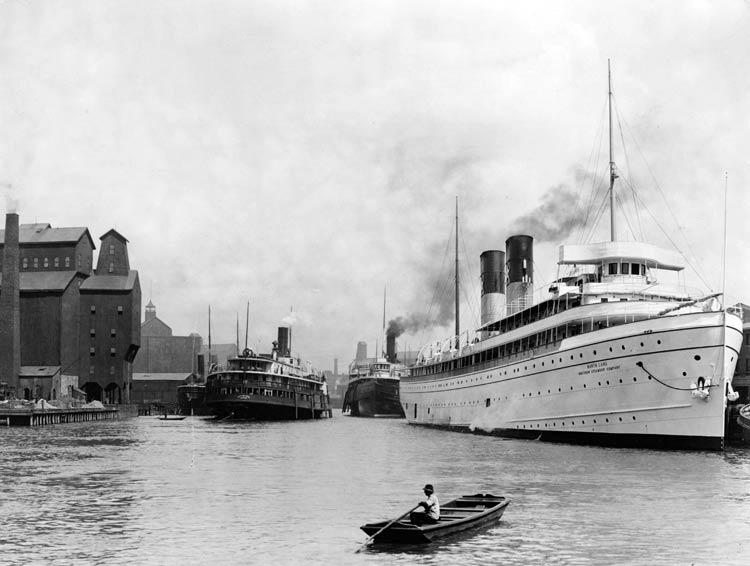James. J. Hill, railroad magnate of the Great Northern Railroad, developed the Northern Steamship Company to connect his freight shipments between Buffalo and Duluth. After constructing six lake freighters, he decided to capture passenger traffic on the Great Lakes and in 1892 began construction on the first of two luxury liners at the Globe Iron Works in Cleveland. His intention was to build the largest and most modern ships on the Great Lakes, equal in every way to the 'ocean greyhounds' in speed and luxury.
The first, named the "North West," was launched in 1894 and, after test runs, came to Buffalo to be finished and furnished. According to J.A. Colby and Sons, of Chicago, their company designed the furniture and upholstery for both liners, using mahogany and primavera (white mahongany) in Louis XV Rococo style. The company described its decor thus: "When we think of the traditional shiny, white cabins we have known so well, this symphony of brown, bronze-green, and gold with the delicate carving and relief work, repeated through such an imposing length of space, all softened by the light of amber-tinted glass, is a marvel... Staircases of white mahogany, with tesselated floors and upholstering of terra-cotta leather; huge plate mirros; balconies furnished in antique brass; reading rooms no less luxurious; ladies' parlors; men's cafe; smoking rooms; little conservatories; bronze and marble statues; a dining-room like a prince's banquet hall; and staterooms of every conceivable shape and size here..."

The ship could carry between 800 and 1,000 per trip, including a crew of 147, most of them dedicated to serving the passengers. The company declared that, unlike the great Atlantic ocean liners, the "North West" had an unlimited supply of fresh water and was able to supply hot and cold water under pressure, with flush toilets in the water closets from pressure tanks. With three hundred separate water fixtures aboard and constant water pressure, the company was able to advertise the ship as especially safe from damage by fire.
The "North West" weighed 2,339 tons, was 385 feet long, 44 feet at the beam, and 34 feet from keel to promenade deck. Its hull was painted white, the three smokestacks painted yellow with a black band near the top, the center stack having a white star and the letter "N" to signify the company. Its two quadruple expansion engines generated 7,000 HP. It had a regular speed of 20 MPH with a 16 foot draft. Its two propellers were 13 feet in diameter. The ship consumed eight tons of coal per hour.
When the "North West" steamed full speed up the Detroit and St. Clair rivers, its huge size created destructive wakes and shore damage;the ship was subsequently obliged to reduce its speed in these areas.
By 1895, the "North Land" had launched, identical to the "North West" except for refinements possible with the newer ship. Both ships maintained service of every three days between Buffalo and Duluth. The regular stops were Buffalo, Cleveland, Detroit, Mackinac Island, Sault St. Marie, and Duluth.
Sam was full of praise for the North Land, and said there wasn't much about the vessel to remind him of the days when he used to pilot a steamboat on the Mississippi river. "It is the best I have ever seen," he said, "in the way of passenger boats. The Fall River steamers are more elaborately decorated, but are more like ocean steamers than the North Land, and not so pleasant and comfortable."
wnyheritage.org/ (original path invalid:)
This source is broken and I can not find a reliable source for the information presented here, although this is not the only copy. JJ Hill is primarily remembered for his railroads and not his steamships.